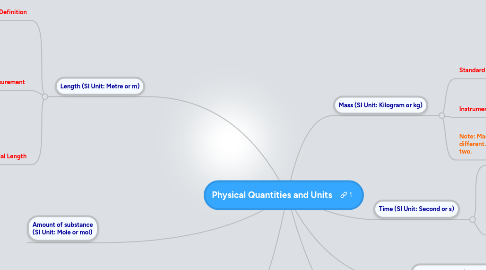
1. Luminous Intensity (SI Unit: Candela or Cd)
2. Amount of substance (SI Unit: Mole or mol)
3. Length (SI Unit: Metre or m)
3.1. Definition
3.1.1. Length of the path travelled by light in a vacuum during a time of 1/299792458 0f a second.
3.2. Instruments of measurement
3.2.1. Metre rule is a common instrument to measure metres. Accuracy: +/-0.01m
3.2.2. Vernier Calipers are less common but are still used. Accuracy: +/- 0.01cm
3.2.3. The Micrometer Screw Gauge is rarer but still often used. Accuracy: +/-0.01mm
3.3. Official Length
3.3.1. The official length of the metre was the distance between two lines on a specific bar of platinum-iridium alloy stored under controlled conditions.
4. Electric Current (SI Unit: Ampere or A)
5. Mass (SI Unit: Kilogram or kg)
5.1. Standard Mass
5.1.1. The standard kilogram is the mass of a certain cylindrical piece of platinum-iridium alloy kept at the International Bureau of Weights and Measures at Sevres, France.
5.2. Instruments of measurement
5.2.1. The electronic beam balance is a very common instrument. Accuracy: +/- 0.1g
5.3. Note: Mass and Weight are different. Do not confuse the two.
6. Time (SI Unit: Second or s)
6.1. Definition
6.1.1. 9 192 631 700 times the period of oscillation of radiation from the cesium atom.
6.2. Instruments of measurement
6.2.1. The analogue stopwatch is an common instrument. Accuracy: +/-0.1s
6.2.2. The digital stopwatch is an extremely common instrument. Accuracy: +/-0.01s
6.2.2.1. Note: Human reaction error = 0.3s
6.2.3. Other uncommon instruments: pendulum, watches and ticker-tape timers.

